- A Short History of Golf
The first written record of golf dates to 1457 when King James II of Scotland issued a law banning the game as it was interfering with his soldiers archery practice...within the Scottish Law texts it says “Golfe be utterly crit doune, and noche usit" which roughly translates as "Golf must be cried down (i.e denounced) , and not played"
What this tells us is that golf must have been sufficiently established by this time for it to warrant being banned. So who invented it and when? The answer to this question has been puzzling historians for several hundred years and the time has in all likelihood past when a true and accurate answer can be given.
We know that many ancient civilizations and early medieval societies enjoyed many variants of ball and stick games. Paganica was played by the Romans, chuiwan by the ancient Chinese, chole by the Flemish in the middle ages, jeu de mail by the French ( which the English in the 1500 called Pall Mall...hence the street of the same name in London), and colf was played by the Dutch in the 13th century. Given that there was considerable trade between the east coast of Scotland and Holland, and the obvious phonetic similarity, it is likely that golf was a derivation of colf. It can still be claimed, however, that golf was first played in Scotland as none of the previously cited games involved putting a ball into a hole in the ground.
Early developments in golf
1457 Golfe...spelt with an "e" on the end(!) banned by King James II of Scotland
1513 - Catherine of Aragon ( Henry VIII's first wife ) mentions "golfe" in a letter
1567- Mary Queen of Scots is known to have played golf following the murder of her husband
1593 - John Henrie and Pat Rogie jailed in Edinburgh for playing "gowff" (note the spelling!) on the links of Leith every Sabbath the time of the sermonises (i.e when they should have been at church).
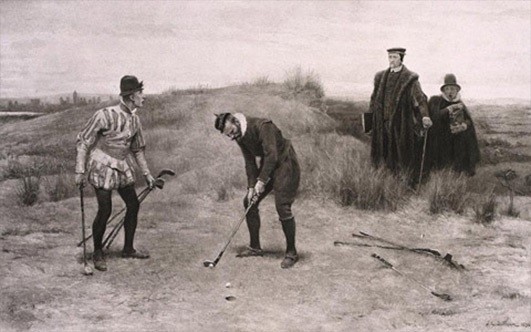
1608 - King James VI of Scotland also becomes James 1 of England and a seven hole course was laid out on Blackheath Common by his Scottish ministers
c1650 golf courses known to exist at Dornoch, Banff, Aberdeen, Montrose, Carnoustie, Perth, St.Andrews, Leven , Leith in Scotland
1744 Honourable Company of Edinburgh Golfers first minuted meeting at Leith links and 13 Rules of the Game drawn up in preparation for a Silver Prize club competition.
1754 St.Andrews Society of Golfers formed (later to be renamed the Royal and Ancient Golf Club of St.Andrews in 1834)
William St.Clair in 1764
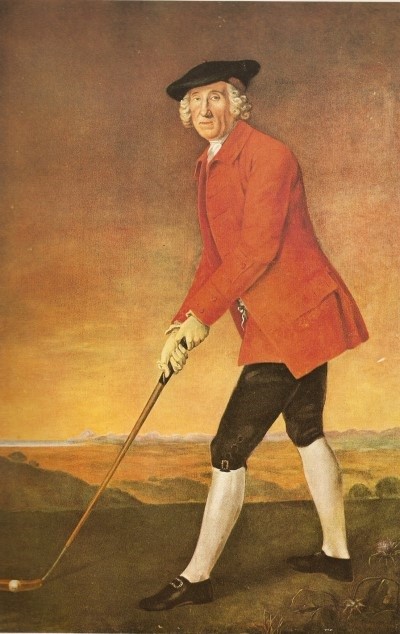
The Blackheah Golfer - William Innes and Caddie on Blackheath Common 1790
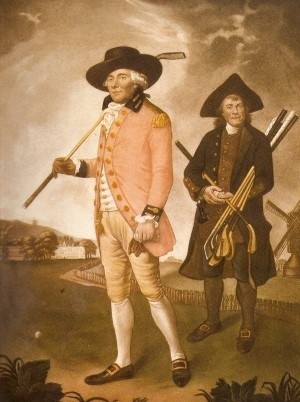
Early Golf Clubs and Balls
Some rare examples of ancient woods and irons remain but it is difficult with any certainty to date them accurately. A set of eight clubs ( 6 woods and 2 irons ), known as the "Troon Clubs", are undoubtedly the earliest set known. There is conjecture just how old the Troon Clubs are....some people believe them to date from about 1603 when King James VI of Scotland became also King James I of England and united the crowns of both countries. I personally believe them to date about 100 years later from about the 1730's or 1740s. I have published an article supporting this...see it in my list of articles.
The Troon Clubs - c.1740. On display in 1996 in the Brirish Golf Museum in St.Andrews, Scotland
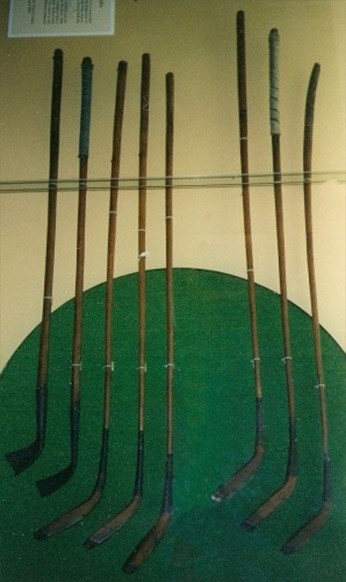
The Troon woods have long and flat heads in s style which prevailed until the 1880's known a "long-nose". Lead is used as ballast within the head and the leading edge is protected by a piece of cattle horn held in place with usually three wooden dowels. The head is joined to the shaft using a "scarf" or "scare" joint (referred to today as scare-neck or splice-neck). In this type of join two flat edges of the separate pieces of wood merely butt up against each other, are glued with adhesive made from animal sinew, and are bound externally with pitched whipping. Some early golf clubs used ash or hazel wood for the shafts as hickory was an imported wood from the Carolinas in North America.
The heads of the two Troon irons are very sweeping in style with no clear point where the hosel ends and the blade begins. These clubs were used only in dire need to escape from bad lies.
It is believed that golf may have been played initially with wooden balls ( taking a lead from the similar Dutch and French games already mentioned ), but it is known that by the 17th century the ball of choice was the "featherie" or "feathery". This ball had an outer skin made from three pieces of leather sewn together, and got its name from the its filling of damp feathers that expanded when dry and gave the ball appropriate solid yet elastic properties. These featherie balls were very labour intensive to make and would have cost the modern equivalent of 50 British Pounds ( 100 US Dollars ).
A full set of clubs for this early period would've consisted of the following. Note, wooden headed clubs were much favoured over the odd iron or two as they were less likely to cause the expensive featherie ball to split. Wooden headed putters were the norm, and clubs were carried loosely in the arms of the caddie as golf bags had yet to be invented!
Wooden Playclub (Driver)
Wooden Long Spoon (3 wood)
Wooden Middle Spoon (5 wood)
Wooden Short Spoon (7 wood)
Wooden Baffing Spoon (9 wood)
Heavy Iron ( no set loft but probabably about a 4 iron )
Light Iron ( no set loft but probably an 8 iron )
Wooden Putter
Here's a picture of perhaps the oldest feathery golf ball still in existence.
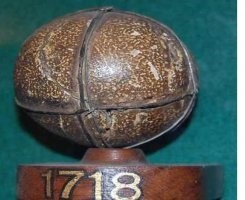
The picture below shows how the design of wooden headed golf clubs evolved from pre-1800 (like the Troon woods), to the mid-1800s ( the black headed club), to the 1880s (late long nose), to the transitional period (1885-1895), to "bulger" headed woods around 1895...and then to socket headed woods of a shape that would remain largely unchanged throughout most of the 20th century. SUPERB HANDMADE REPLICA TROON CLUBS NOW AVAILABLE FOR PURCHASE THROUGH THIS WEBSITE- Contact me for details!!!
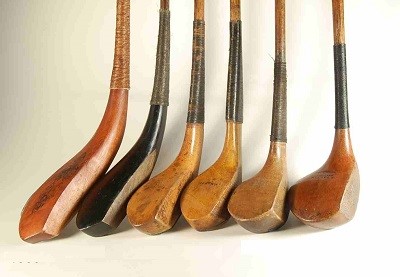
* UPDATE...More details about the Troon Clubs and My Theory of Origin can be found here.